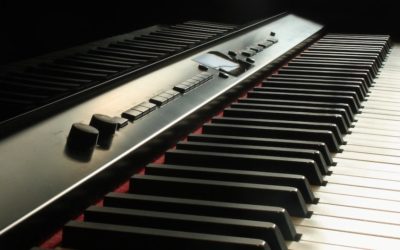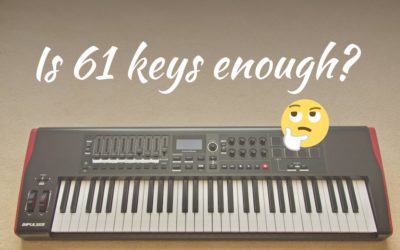Things to consider when buying digital piano
In case you are on a hunt for your first digital piano, you might be wondering what are the main things to consider when buying a new piano? As it is with many things, there is no one fit for all solution since every musician has different needs, preferences, and uses for the instrument. The following list of things I consider important is written from a perspective of a person who plays the instrument daily and also travels with the instrument quite frequently, so keep in mind, that the things I consider important not necessarily have to apply to you. The list is written in descending order, starting with the ones I consider to be the most important moving on to the less significant ones.
1. Quality of piano action
If I had to point out one thing I consider to be the most important on this list, it would be the piano action. When choosing the right piano action, I’m looking for an authentic and realistic feel of the keyboard, which resembles a traditional acoustic piano keyboard as much as possible. If you are wondering which digital piano has the best keyboard, there is not a simple answer to that. For me, Roland’s FP-90 PHA-50 keyboard action is one of the best I’ve ever played, but it all comes down to personal preference. Other major brands have great actions too. However, they may have a little bit different feel to them. Some people prefer heavier actions, while others lighter. The best way to choose the right piano action is by trying out multiple piano brands and models and picking the one that feels the best to you.
If you are planning to spend over $1,500 on a digital piano, the chances are you are not going to be disappointed with most major brands such as Roland, Yamaha, Korg, Nord, Kawai, etc.
Making sure you have the right piano action is especially important if you have a tight budget as I tend to feel the biggest differences are in the $500-1,000 price range.
2. Weight/Portability
Weight and size of the piano can be a very important factor if you plan on traveling with your instrument on a regular basis. When I was looking for my first digital piano, I didn’t think much about the weight and size of the instrument, since I thought my love for the music is so big I’m willing to carry even a baby grand. Thankfully once I got to my local piano shop to try out a couple of different pianos I quickly came to my senses. Eventually, I chose the Roland FP-4F weighing little over 36 lbs. (16,6 kg) over FP-7F model weighing 52 lbs. (24 kg). Carrying around different instruments over the years made me realize that 40 lbs. is about as much as I’m willing to carry with me on a weekly basis.
For better representation, I’ve created a portability scale based on the weight of the majority of digital pianos. Most of them weigh between 22 and 66 lbs. (10 – 30 kg). Sure, you might find instruments that might be a little heavier or a bit lighter, but most of them will fall somewhere within this weight range.
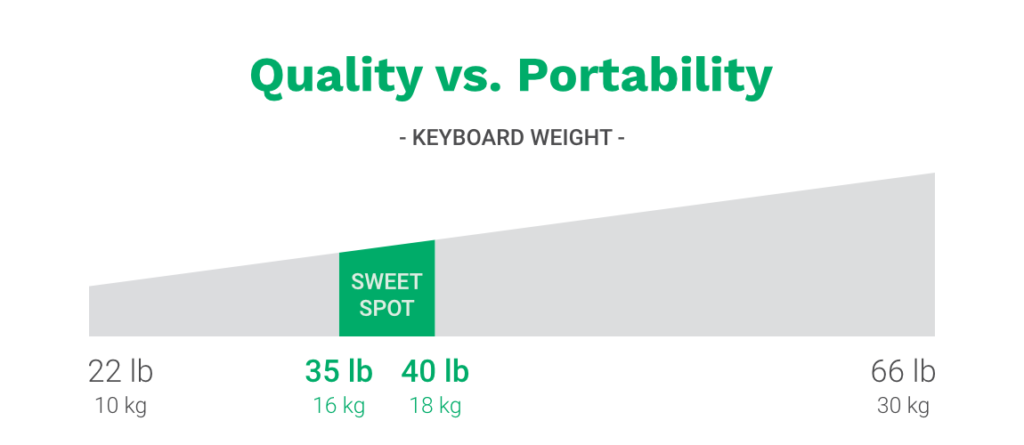
Size of the instrument also matters, but I found it much less important than weight, as I have never had a problem to fit different 88 key keyboards even to my small Renault Clio.
When you are thinking about portable setup, you don’t want to forget about other stuff you are going to carry with you. Things such as piano accessories, piano stand, amplifier, etc. should be most definitely added to the equation. It is great to have a lightweight keyboard, but it’s not going to be very helpful if you couple it with an amp such as Roland KC-200 which will instantly double the weight of your setup.
3. Built quality
A well-built instrument will last you for years. Therefore, it is important to consider materials the instrument is made of, especially if you plan on traveling with it on a regular basis.
Even the best quality instruments today are at least partially made of plastic, so its nothing to be afraid of. On the other hand, it’s not uncommon to find a digital piano with a metal chassis which in my experience is preferable as it’s much more durable material. The most important part of the instrument is the keyboard, so look for a good feel of the keyboard as well as wide dynamic range. It’s also great to see higher quality materials being incorporated in the construction of the keys such as wood or synthetic ivory keytops, which mimic the feel and properties of real ivory keys.
When judging the general built quality of an instrument, use your common sense. You want to avoid flimsy and wobbly buttons, noisy piano action, or an instrument made of cheap plastic that squeaks and bends under slight pressure. You don’t have to spend a fortune on a good quality instrument, but I wouldn’t go for the cheapest options either.
4. Connectivity
One of the things I overlooked and didn’t pay much attention to when I was purchasing my first digital piano was connectivity. As a beginner, it wasn’t something I considered very important since I used the instrument solely for practicing at home. A few years further down the line as I progressed in my piano playing skills and wanted to use the instrument for live performance, I found out that it’s not suitable for this purposes due to lack of output connectors which would allow me to connect the instrument to the PA system.
Nowadays, I considered connectivity as one of the most important factors when looking for a good, futureproof instrument that I can play for many years to come.
Here is the list of connectors I consider a must:
– stereo output connectors for connecting with mixing console or amp
– stereo input connectors (or input stereo jack) for receiving an audio signal from computer/audio device
– headphones output
– USB midi connector (or at least MIDI (Out/In) connectors) – mainly to be able to operate and play virtual instruments on a computer.
– connector for sustain pedal (but most likely there is no digital piano without it)
5. Ease of use/usability
Switching between your favorite sounds, transposing, layering different sounds on top of each other or anything you may consider important when playing shouldn’t be a hassle to do. In a press of a button or two, you should be able to dial in the most important functions on the instrument. It is a very important factor, especially when performing live. Playing live can be a stressful thing on it’s’ own, so the last thing you want to do is dig through menus to find the thing you’re looking for. Obviously, it’s great to have a broad spectrum of options to fine-tune the piano to your liking, but it should not get in the way of good usability.
How to spot a potentially problematic and difficult to use digital piano? From my experience, the first signs of a complex piano is a big LCD and very few buttons. It may sound counterintuitive, but more buttons can indicate a simpler way of interacting with the instrument since it’s more likely things will be in reach within a press of a button. A good example of this type of instrument can be Yamaha P125 B, which is a good value for the money and easy to use. If you want something on a higher-end spectrum with good sound quality, and great piano action than Roland FP-90 can be an excellent choice.
6. Speakers or without speakers
Digital piano with built-in speakers is a great feature to have. Over the years of using my Roland piano, I became quite appreciative of them. There were many instances where I found myself on a set without any monitor, even though I was supposed to have one. It is not uncommon in smaller venues, churches, schools, etc., where a lot of things are done by volunteers and enthusiasts, to find yourself in this kind of situation. Then your only option are your internal speakers. Shure, most of the time, the quality of the internal speakers isn’t great, and I would not recommend to use them as a primary monitor for live performances. But for practicing purposes, for choir rehearsals or in case of emergency, when there is no extra monitor, it will get the job done. I would not consider this feature as important as previous points, but if you can find a piano that ticks the boxes you consider important and has speakers, then it is definitely a welcomed bonus.
7. Sound quality
A realistic, beautiful, and inspiring sound of a digital piano is very important, as this is the factor which will entice you to play the instrument. Poorly sampled piano sounds or its emulations can be quite tiresome and unpleasant to listen to after a while, so you want sounds that are pleasant to your ears. You may ask yourself – if this is so important why it is not number 1 on his list? The reason is simple, with today’s state of technology and ability to use 3rd party plugins I find the sound quality of built-in sounds less and less important. Nowadays, 99 % of the time when I play my digital piano, I use virtual instruments. Depending on your preferences and needs it could be a good idea to consider buying a cheaper digital piano or even a midi keyboard with weighted keys and use it as a controller for playing sounds off of your computer. For as little as $100, you can purchase virtual piano plugins from companies such as Native Instruments or ViLabs that will sound better and more realistic than most of the top tier digital pianos with built-in sound libraries. Of course, since you have to carry around your laptop with you, it is not the most convenient and user-friendly way of playing your instrument, but if you are a techy person like me who wants the best sound quality and experience playing your instrument, this might be a great option. Just don’t forget to check if the piano you want to purchase has all the necessary ports (see tip no. 4) to be able to connect with your mac/PC so that you can use virtual instruments later on.
TIP.: If you can’t decide between choosing a midi controller with weighted keys or a digital piano, be aware of the fact that with a midi controller, you will be solely dependant on your computer. If the app crashes during your performance, there will be no backup sound. This may not be a problem for practicing purposes at home, but I wouldn’t choose this option for live performances, as it is always better to have a backup sound in case of unforeseen situation.
8. Sound library
As you may guess from my previous point, the sound library isn’t amongst the most important factors I would recommend to focus on when choosing the right piano. With today’s technology and the ability to replace the stock sounds easily, it shouldn’t be a big priority, but I wouldn’t completely neglect this (factor) either. When looking at the sound library on the instrument, I generally recommend focussing on quality over quantity of the sounds, especially those you tend to use most frequently. As a pianist who plays mainly at the church, I find myself going back to 4 or 5 different sounds (piano, rhodes, strings, and pads), and those are the sounds I would recommend to test whether you like them or not. Unless a huge variety of sounds is something you consider essential or necessary for the style o playing you are going for, then I would always recommend focussing on the quality of your favourite sounds.
9. Design
Although a digital piano is an instrument first, for many homes, it can also become an integral part of esthetic and design of a particular room. If you fall into this category, then you should definitely consider whether the instrument fits into the overall design of the room. With today’s broad spectrum of instruments, you don’t have to compromise on the functionality of the instrument if you have the budget.
10. The “IT” factor
Last but not least, you should take into consideration the “it” factor! In my opinion, playing the piano is supposed to be about having fun with the instrument. Sometimes it can be hard to pinpoint/articulate why exactly you like a particular piano more than other ones since multiple factors create the general impression of the instrument. This is what I call the “it” or the “fun” factor. As much as I think it is important to consider all previous points when looking for your new piano, you shouldn’t neglect the initial impression of the instrument either.

Welcome to my blog!
Hi, I’m Kuba! Music, instruments and piano has been a big part of my life for quite some time (actually over 20 years)! I come here and write about what I’ve lerned, gear or anythings else piano related. I hope you will find this site helpful.
Other Articles

Worship piano: the ultimate guide for beginners
If you're anything like me, then you probably consider music to be one of the most amazing gifts from God. As a kid, I wasn't always excited about attending the Sunday service, but I remember that the time of praise and worship was my favorite part of the service, and...
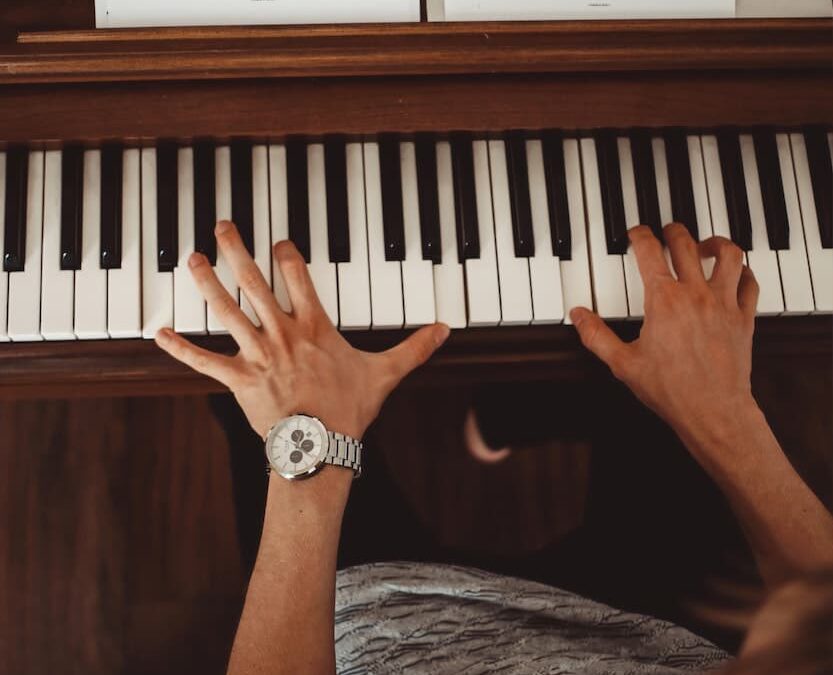
7 Ways to Make Your Chords More Interesting (tips for piano beginners)
Probably all of us face moments when we reach a plateau in our playing. Those are times when it's a good idea to seek out some inspiration to overcome the rut. If you're bored of playing the same chords over and over again, wondering how to make your chords sound more...
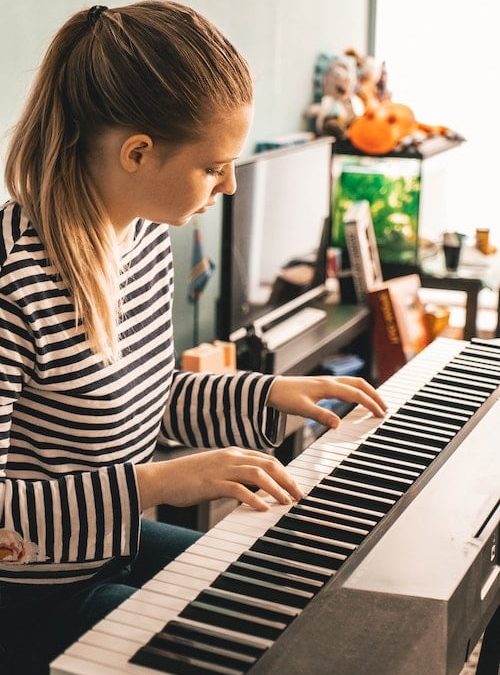
How to learn songs by ear
I was around 13 years old and had been thinking about quitting my piano endeavors because, for the past six years, I was almost exclusively playing classical music, which as a kid I didn't enjoy. As much as my classical training helped me develop my piano technique,...
Related Articles
Best digital piano for church
If you are looking for a digital piano for your church, you might be wondering what are the key factors and features I should consider before the purchase? There are dozens of factors you can take into account, but not all of them are equally important.I've been...
Is a 61 key keyboard enough?
If you are a beginner looking for your first piano, odds are that you are overwhelmed by the things that go into choosing your first instrument. This is nothing to be surprised about due to the complexity of keyboard instruments as well as increasing pace of...

